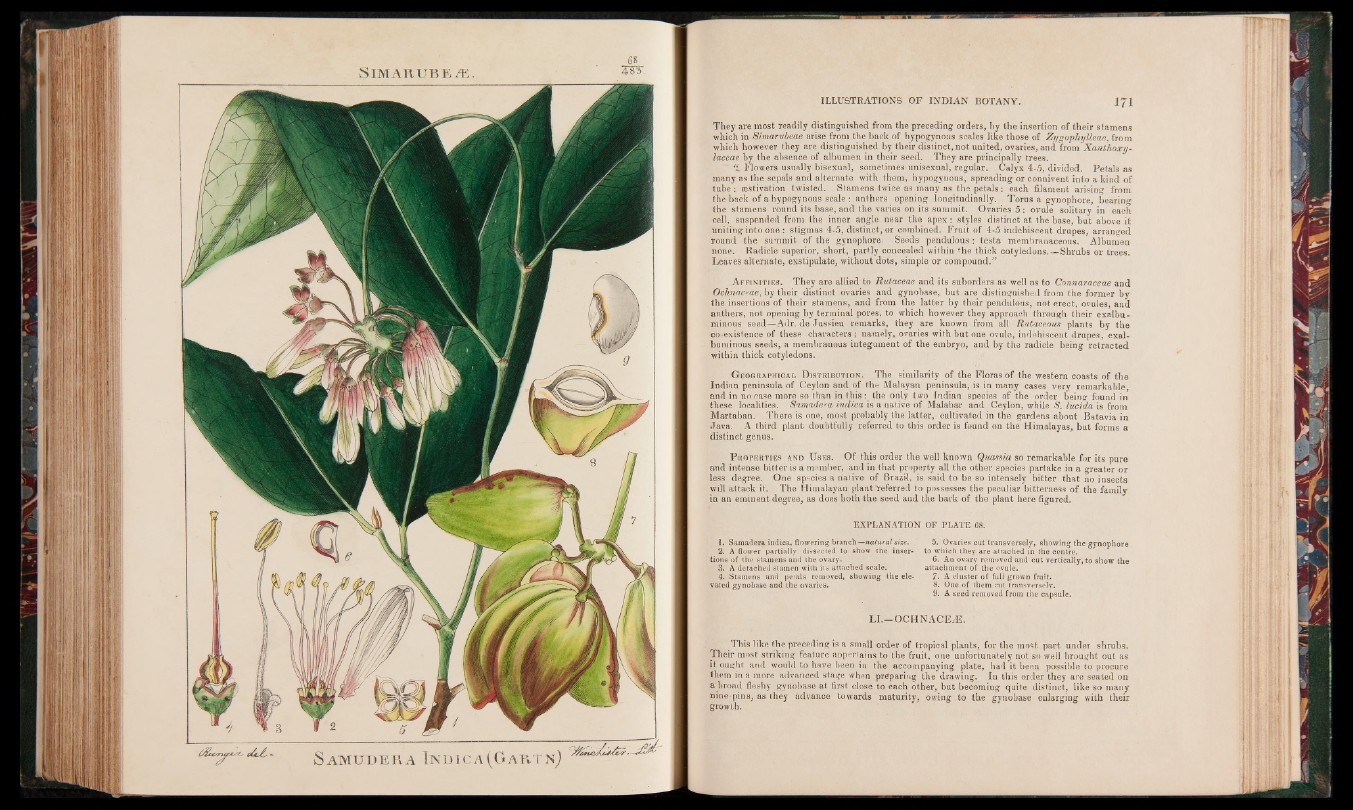
SlMAKUBEÆ
,68
483.
They are most readily distinguished from the preceding orders, by the insertion of their stamens
which in Simarubeae arise from the back of hypogynoas scales like those of Zygophylleae, from
which however they are distinguished by their distinct, not united, ovaries, and from Xanthoxy-
laceae by the absence of albumen in their seed. They are principally trees.
Flowers usually bisexual, sometimes unisexual, regular. Calyx 4-5, divided. Petals as
many as the sepals and alternate with them, hypogynous, spreading or connivent into a kind of
tube: Eestivation twisted. Stamens twice as many as the petals: each filament arising from
the back of a hypogynous scale : anthers opening longitudinally. Torus a gynophore, bearing
the stamens round its base, and the varies on its summit. Ovaries 5 : ovule solitary in each
cell, suspended from the inner angle near the apex: styles distinct at the base, but above it
uniting into one : stigmas 4-5, distinct, or combined. Fruit of 4-5 indehiscent drupes, arranged
round the summit of the gynophore Seeds pendulous : testa membranaceous. Albumen
none. Radicle superior, short, partly concealed within *he thick cotyledons.—Shrubs or trees.
Leaves alternate, exstipulate, without dots, simple or compound.”
A f f in i t i e s . They are allied to Rutaceae and its suborders as well as to Connaraceae and
Ochnacrae, by their distinct ovaries and gynobase, but are distinguished from the former by
the insertions of their stamens, and from the latter by their pendulous, not erect, ovules, and
anthers, not opening by terminal pores, to which however they approach through their exalbu-
minous seed—Adr. de Jussieu remarks, they are known from all Rutaceous plants by the
coexistence of these characters; namely, ovaries with but one ovule, indehiscent drupes, exal-
buminous seeds, a membranous integument of the embryo, and by the radicle being retracted
within thick cotyledons.
G e o g r a p h ic a l D is t r ib u t io n . The similarity of the Floras of the western coasts of the
Indian peninsula of Ceylon and of the Malayan peninsula, is in many cases very remarkable
and in no case more so than in this: the only two Indian species of the order being found in
these localities. Samridem indica is a native of Malabar and Ceylon, while S. lucida is from
Martaban. There is one, most probably the latter, cultivated in the gardens about Batavia in
Java. A third plant doubtfully referred to this order is found on the Himalayas, but forms a
distinct genus.
P r o p e r t ie s a n d U s e s . Of this order the well known Quassia so remarkable for its pure
and intense bitter is a member, and in that property all the other species partake in a greater or
less degree. One species a native of Brazil, is said to be so intensely bitter that no insects
will attack it. The Himalayan plant deferred to possesses the peculiar bitterness of the family
in an eminent degree, as does both the seed and the bark of the plant here figured.
EXPLANATION OF PLATE 68.
1. Samadera indica, flowering branch—natural size.
2. A flower partially dissected to show the insertions
of the stamens and the ovary.
3. A detached stamen with its attached scale.
4. Stamens and petals removed, showing the elevated
gynobase and the ovaries.
5. Ovaries cut transversely, showing the gynophore
to which they are attached in the centre.
6. An ovary removed and cut vertically, to show the
attachment of the ovule.
7. A cluster of full grown fruit.
8. One of them_cut transversely.
9. A seed removed from the capsule.
LI.—OCHNACEÆ.
; This like the preceding is a small order of tropical plants, for the most part under shrubs.
Their most striking feature appertains to the fruit, one unfortunately not so well brought out as
it ought and would to have been in the accompanying plate, had it been possible to procure
them in a more advanced stage when preparing the drawing. In this order they are seated on
a broad fleshy gynobase at first close to each other, but becoming quite distinct, like so many
nine-pins, as they advance towards maturity, owing to the gynobase enlarging with their
growth.